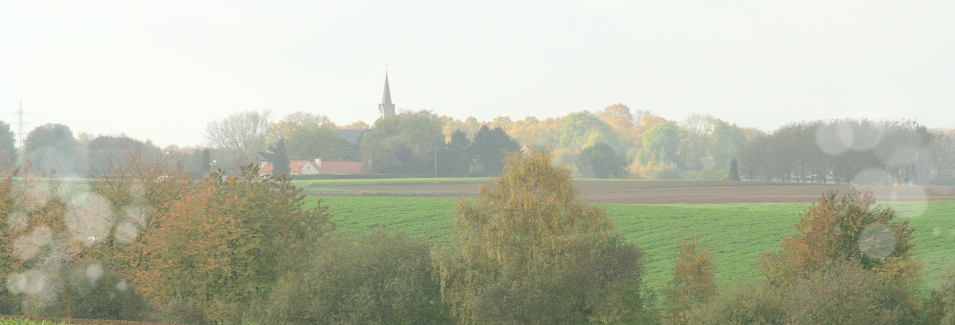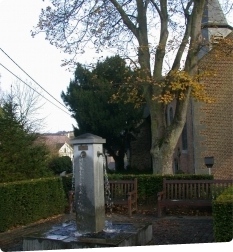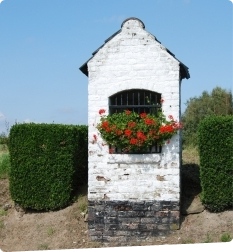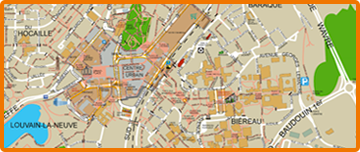

Contact
us

Discovery tour
Newsletter
Get tourist news on Ottignies-Louvain-la-Neuve


Walk to Mousty
Promenade No. 6: Mousty - Limauges
This walk allows all of the residents of Ottignies-Louvain-la-Neuve, and others, to travel the countryside between Limauges and Croix Thomas following the reopening of path no.24, passing by the Champ d’Enfer (“Hell Field”).
We invite you to use this trail as a connecting point between the hamlets, while wearing good sneakers or boots.
1. Mousty Church
Listed in 1952, the Mousty church has three particularities. The first is its layout, which is similar to that of a monastery; the second is its crypt, under the choir, a space of relic veneration for pilgrims and the sick; the third is “nature”: in the summer, the church attic is home to a colony of long-eared bats, these small bats have ears that are almost as long as their bodies. In the winter, the long-eared bats abandon the space to profit from subterrain cavities sheltered from frost.
2. The Tawery
Once an important industrial site, the tawery served as a depot for the municipal department of Environmental Works for several years. Today it is the location of a European project to structure the site for the future development of Ottignies-Louvain-la-Neuve. The project anticipates the patrimonial and natural enhancement of the site with its close proximity to the Dyle.
3. Champ d’Enfer (Hell Field)
Just after the Centenary square and its Japanese cherry trees, take Rue du Champ d’Enfer on the left which quickly turns into a pedestrian path. The embanked landscape of the path is due to erosion caused by removing ground and rain. The vegetation retains the slopes, but it is fragile: too much trampling destroys it, which promotes rain erosion and results in downstream silt. This path plays an essential role in ecological linking because it serves as a liaison between different wooded areas of the municipal territory.
4. The sandpits
Before reaching the plateau, sand was used on both sides of the path. On the right, the quarry today is totally filled in. On the left, it is still well visible and, little by little, is filled in with dirt.
5. The plateau
On the plateau, the landscape opens up. It is home to many plants, hares, larks and partridges. If you go back and look towards the east, you will enjoy a beautiful view over the valley. In the distance, you will see the Blocry water tower.
The plateau is crossed by two high tension power lines, very visible from their location on a crest line. A few years ago, the Noctua nonprofit organization installed a kestrel hawk nest box. Today, eleven nest boxes are attached to the Corbais-Céroux high tension power line, in collaboration with Elia. These nest boxes are all occupied during the nesting period (March to April).
6. Path no. 24
At the junction, path no. 24, recently reopened by the community at the initiative of the Nature Development Community Plan (PCDN), begins. The beginning, in a hollow path, has beautiful remnants of a hedge that shelters a superb hawthorn. These sites are interesting because they offer shelter for a large number of species: hedgehogs, insectivore birds…After the 100 m hedge, one passes through the fields. Towards the South, when the weather is clear, the windmills of Sombreffe can be seen-with binoculars!
7. The fallow
For several years, the fallow-which implicates a halting in commercial production-has reappeared in the agricultural landscape. It may be spontaneous or sowed. For nature, it offers various advantages: the animals there are barely affected, and in a way, are protected given the rarity of authorized interventions. It is also an important asset for the landscape.
8. Croix Thomas Chapel
Before taking the Padri Céroux path, you pass the chapel of Croix Thomas near which a limewood was planted. Folklore says that storms do not affect this area. This phenomenon is explained by the winds ascending from the valley. When these winds blow in the same direction as the storm, be careful for flooding in the valley because Rue du Culot, Rue du Champ Rue d’Enfer and Rue de la Vallée drain all of this water to only one point.
9. Irrigation of Puits
The irrigation system of Puits, drilled in 1984 and 132 m in depth, supplies some of the homes of Ottignies. Between 1984 and 2001, the concentrations of nitrate and herbicides in pumped water increased, without however exceeding the authorized concentration. Today, 6 m³/h of water is irrigated and it is mixed with the waters from Sauvagemont to meet drinkability standards before distribution. In 2003, the control areas (close and far) were determined for regulating activities.
10. The hamlet of Puits
This hamlet was the birthplace of Céroux. It owes its name to the wells dug next to the Sainte-Catherine chapel. On your left, you will notice a beautiful brick farm built in the 19th century by the Rauscent family, identical to the one built by the same family in Pinchart. In the meadows behind the farm, there is a beautiful listed chestnut tree. These meadows are occupied by several little owls and screech owls.
11. Towards Bon Air
Whether you are taking path no. 22 which crosses the fields, or you continue until the edge of Puits before turning to the right,you once again have a beautiful view of Ottignies and the Saint-Pierre clinic.
12. The Brickworks Factory
Nothing of the old brickworks factory remains except a few remnants of the walls. The giants of the district –Jean-Joseph and Charlotte, brick workers of the Bon Air district – occasionally make an appearance during various folklore events.
13. Rue de la Briqueterie (Brickworks Street)
This road was paved not too long ago for bike paths connecting Mousty to Petit Ry.
14. Rue du Cimetière (Cemetery Street)
This is a hollow, forest path. The dominant species are the oak, ash and sycamore maple. The ground is covered with a carpet of ground ivy. There are also several types of undergrowth like vaens, “Herb Robert” Geranium, and brambles.
You will come to the Mousty church by path no. 4 on the right, then continue straight down Rue de la Briqueterie and Rue du Cimetière.







